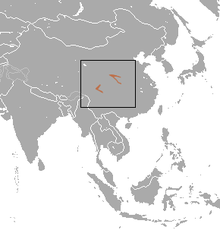Smith shrew
| Smith shrew | ||||||||||||
|---|---|---|---|---|---|---|---|---|---|---|---|---|
| Systematics | ||||||||||||
|
||||||||||||
| Scientific name | ||||||||||||
| Chodsigoa smithii | ||||||||||||
| Thomas , 1911 |
The Smith shrew ( Chodsigoa smithii ) is a species of shrew from the genus Chodsigoa . It is endemic to the People's Republic of China , where it is only known from mountain forests at altitudes over 3000 meters.
features
With a head-trunk length of 7.2 to 9.6 centimeters, the Smith shrew is one of the medium-sized shrew species. The tail reaches a length of 92 to 108 millimeters and is thus significantly longer than the body, the rear foot is 16 to 19 millimeters long. The back and belly color is dark gray-brown, with the belly being a little lighter. The tail is pale brown on top and white on the underside. The tops of the feet are brown and white. Compared to the lion shrew ( Chodsigoa parca ), which looks very similar , the species is somewhat larger and somewhat darker in color, at the same time it is somewhat smaller than Chodsigoa salenskii .
| 1 | · | 3 | · | 1 | · | 3 | = 28 |
| 1 | · | 1 | · | 1 | · | 3 |
The skull of the Smith shrew is 21 to 23 millimeters in length. Compared to Chodsigoa parca , the snout area is wider and tapers more in the area of the premaxillary . Like all species of the genus has the type in the maxilla per half an incisor (incisor) and then three unicuspid teeth, a Vorbackenzahn (premolar) and three molars (molar). In the lower jaw, however, it has a single canine behind the incisor. In total, the animals have a set of 28 teeth. The tooth roots are colored red as in most red-toothed shrews.
distribution
The Smith shrew is endemic to the People's Republic of China in the provinces of Sichuan , Chongqing , southern Shaanxi, and Hubei . Most of the individuals were found at altitudes above 3000 meters. The species occurs sympatric with the De Winton shrew ( Chodsigoa hypsibia ). The species lives largely allopatric to the Lowe's shrew , but a sympatric occurrence has been proven for at least one locality .
Way of life
As with most other Asian shrews, very little data is available on the way of life of this species. Like all shrews, the Smith shrew feeds on invertebrates and lives on the ground. The species is probably tied to forests in mountainous areas at an altitude of over 3000 meters, where most of the finds so far have been made. Because of the large hind feet and long tail, the animals are believed to be better climbers than most other species of shrew.
Systematics
The Smith shrew is classified as a separate species within the genus Chodsigoa , which consists of eight species. The first scientific description comes from Oldfield Thomas from 1911, who had an individual from the Chinese province of Sichuan available. The species was classified as a subspecies of Chodsigoa salenskii for a while , but was given species status again in the 1970s. It also contained Chodsigoa parca and its subspecies Chodsigoa parca furva as subspecies.
Apart from the nominate form Chodsigoa smithii smithii, no further subspecies are distinguished within the species .
Threat and protection
The Smith's shrew is classified by the International Union for Conservation of Nature and Natural Resources (IUCN) as “near threatened” due to the strong decline caused by the loss of suitable habitats in its range. It is believed that populations will decline by more than 30% over the next ten years and therefore future classification as an endangered species is possible.
literature
- Robert S. Hoffmann, Darrin Lunde: Smith's shrew In: Andrew T. Smith , Yan Xie: A Guide to the Mammals of China. Princeton University Press, Princeton 2009, ISBN 978-0-691-09984-2 , p. 308.
Web links
- Chodsigoa smithii inthe IUCN 2013 Red List of Threatened Species . Listed by: AT Smith, CH Johnston, 2008. Retrieved July 28, 2013.
supporting documents
- ↑ a b c d e f g h Robert S. Hoffmann, Darrin Lunde: Smith's shrew In: Andrew T. Smith , Yan Xie: A Guide to the Mammals of China. Princeton University Press, Princeton 2009, ISBN 978-0-691-09984-2 , p. 308.
- ↑ a b c Robert S. Hoffmann, Darrin Lunde: Lowe's shrew. In: Andrew T. Smith , Yan Xie: A Guide to the Mammals of China. Princeton University Press, Princeton 2009, ISBN 978-0-691-09984-2 , p. 308.
- ↑ a b c d Chodsigoa smithii in the IUCN Red List of Threatened Species 2013.1. Listed by: AT Smith, CH Johnston, 2008. Retrieved July 28, 2013.
- ↑ a b c d Chodsigoa smithii ( Memento of the original from November 10, 2013 in the Internet Archive ) Info: The archive link has been inserted automatically and has not yet been checked. Please check the original and archive link according to the instructions and then remove this notice. . In: Don E. Wilson , DeeAnn M. Reeder (Eds.): Mammal Species of the World. A taxonomic and geographic Reference. 2 volumes. 3. Edition. Johns Hopkins University Press, Baltimore MD 2005, ISBN 0-8018-8221-4 .
